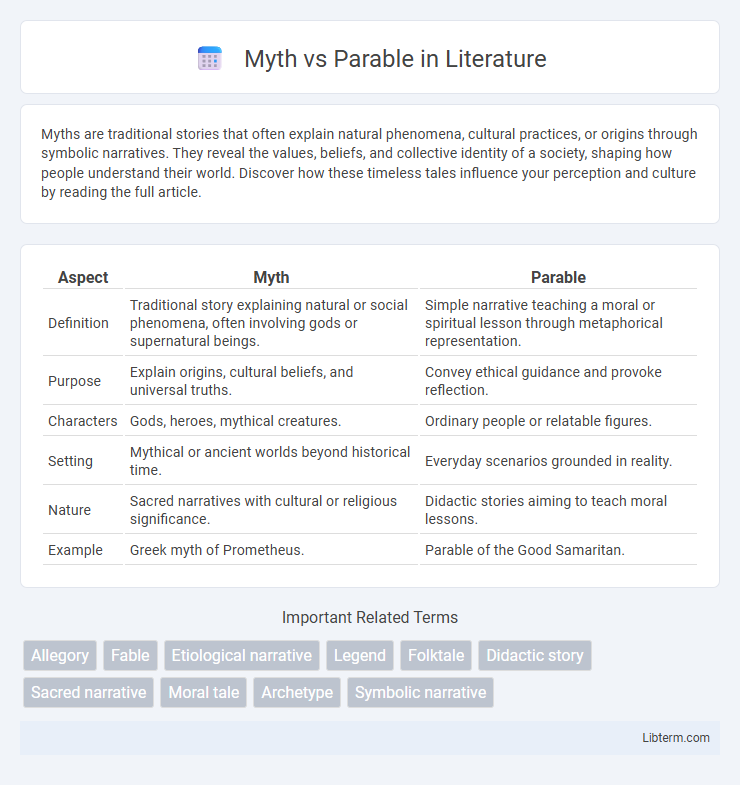Myths are traditional stories that often explain natural phenomena, cultural practices, or origins through symbolic narratives. They reveal the values, beliefs, and collective identity of a society, shaping how people understand their world. Discover how these timeless tales influence your perception and culture by reading the full article.
Table of Comparison
| Aspect | Myth | Parable |
|---|---|---|
| Definition | Traditional story explaining natural or social phenomena, often involving gods or supernatural beings. | Simple narrative teaching a moral or spiritual lesson through metaphorical representation. |
| Purpose | Explain origins, cultural beliefs, and universal truths. | Convey ethical guidance and provoke reflection. |
| Characters | Gods, heroes, mythical creatures. | Ordinary people or relatable figures. |
| Setting | Mythical or ancient worlds beyond historical time. | Everyday scenarios grounded in reality. |
| Nature | Sacred narratives with cultural or religious significance. | Didactic stories aiming to teach moral lessons. |
| Example | Greek myth of Prometheus. | Parable of the Good Samaritan. |
Introduction: Defining Myth and Parable
Myths are traditional stories rooted in ancient cultures that explain natural phenomena, origins, and societal values through supernatural elements and deities. Parables are concise, instructional narratives often found in religious or moral contexts designed to convey ethical lessons or spiritual truths. Both forms employ symbolic storytelling but differ in purpose, with myths aiming to explain existence and parables focusing on moral guidance.
Historical Origins and Cultural Contexts
Myths originate from ancient societies as traditional narratives that explain natural phenomena, creation, and gods, reflecting the religious beliefs and worldviews of specific cultures. Parables, rooted primarily in religious and moral teachings, serve as simple stories with ethical lessons used across various cultures, particularly in Judeo-Christian contexts. The historical origins of myths are deeply intertwined with the collective identity and rituals of early civilizations, while parables are employed as didactic tools to convey spiritual and moral truths within evolving social frameworks.
Structure and Narrative Style
Myths typically feature a structured narrative with archetypal characters and cosmic themes, often explaining natural phenomena or cultural origins through symbolic storytelling. Parables employ a simpler, didactic narrative style, using everyday scenarios and relatable characters to convey moral or spiritual lessons succinctly. The structured, often grandiose style of myths contrasts with the concise, pointed narrative approach characteristic of parables.
Purpose and Function in Society
Myths serve to explain fundamental aspects of human existence, natural phenomena, or cultural origins, often rooted in sacred traditions and collective beliefs. Parables function primarily as moral or ethical teachings, using simple storytelling to impart lessons and guide behavior within a community. Both myth and parable reinforce social norms and values, but myths provide a foundational worldview while parables emphasize practical wisdom for everyday life.
Symbolism and Allegory: What They Convey
Myths use symbolism to convey foundational cultural beliefs and explain natural phenomena through gods, heroes, and cosmic events, reflecting collective values and existential questions. Parables employ allegory to impart moral or spiritual lessons through simple, relatable narratives, often focusing on human behavior and ethical teachings. Both forms leverage symbolism and allegory to communicate deeper meanings beyond literal interpretations, influencing cultural worldviews and guiding social conduct.
Famous Examples of Myths and Parables
Myths like the Greek tale of Zeus and the Titans explain cosmic origins and divine conflicts while parables such as Jesus' The Good Samaritan teach moral lessons through simple narratives. The myth of King Arthur explores heroism and legend, whereas the parable of the Prodigal Son highlights themes of forgiveness and redemption. Both forms use storytelling to convey deeper cultural, spiritual, or ethical truths across generations.
Interpretation and Meaning
Myths often convey fundamental cultural truths and cosmological explanations through symbolic narratives that require interpretation within their mythological context. Parables, by contrast, are simplified stories designed to impart moral or spiritual lessons with clearer, more direct meaning intended for practical application. Understanding myths demands analyzing symbolic layers, while parables emphasize straightforward ethical guidance.
Myth vs Parable: Key Differences
Myths are traditional stories rooted in cultural beliefs that explain natural phenomena, origins, or customs, often involving gods or supernatural beings, whereas parables are simple, didactic stories designed to teach moral or spiritual lessons through everyday events. Myths serve to convey broader existential or cosmological themes, while parables emphasize ethical guidance and practical wisdom. The key difference lies in myths' focus on explaining reality versus parables' emphasis on instructing behavior.
Influence on Modern Literature and Thought
Myths shape modern literature and thought by providing archetypal narratives and universal themes that explore human nature, morality, and the cosmos, influencing genres from fantasy to psychoanalysis. Parables contribute to contemporary discourse through their concise, allegorical storytelling that imparts ethical lessons and challenges readers to reflect on personal and societal values. Both forms serve as foundational tools in shaping cultural identity, philosophical inquiry, and narrative structures across diverse literary traditions.
Conclusion: Relevance Today
Myths continue to shape cultural identities by conveying timeless spiritual and moral truths through symbolic narratives, while parables offer practical ethical lessons applicable to everyday decision-making. Both forms reinforce values and provoke reflection, maintaining their relevance across diverse societies in contemporary contexts. Modern media and education integrate myths and parables to foster critical thinking, empathy, and cultural awareness.
Myth Infographic

 libterm.com
libterm.com